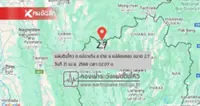
Last May, an advanced critical long-range radar system used by China to detect stealth aircraft and ballistic missiles was temporarily disabled by a massive solar storm – a disruption that set off alarm bells over a key vulnerability of the system, according to a top Chinese space scientist.
The solar storm destabilised the ionosphere, which the “skywave” radar surveillance tools rely on to operate. The event revealed weaknesses of over-the-horizon (OTH) radar technology, which uses ionospheric reflection to monitor targets up to 3,000km (1,860 miles) beyond the Earth’s curvature.
The systems, prized for their ability to pierce the low-observable features of stealth aircraft, failed during the storm, which also triggered global short wave communication outages.
Do you have questions about the biggest topics and trends from around the world? Get the answers with SCMP Knowledge, our new platform of curated content with explainers, FAQs, analyses and infographics brought to you by our award-winning team.
China’s answer to the problem is the Meridian Project Phase II – a just completed cutting-edge space weather monitoring network that Beijing has hailed as the world’s largest and most sophisticated system of its kind.
The matrix of 31 ground stations and 282 instruments, including ultra-sensitive lasers and a revolutionary solar-imaging radio telescope, acts like a CT scan for near-Earth space.
The network, which has supported more than 60 national space missions, will be integrated with satellites so that early warnings for solar-induced disasters can be issued, safeguarding critical infrastructure from cascading satellite, navigation, and power grid failures.
In an interview with state news agency Xinhua last month, Wang Chi, a member of the Chinese Academy of Sciences and director of the National Space Science Centre, revealed that a solar storm last year had temporarily crippled China’s long-range “skywave” radars.
The OTH radar referred to by Wang is designed to detect air and maritime targets far beyond the horizon. By leveraging the reflection of electromagnetic waves between the ionosphere and the Earth’s surface – or their diffraction along the planet’s curvature – these systems can overcome the limitations imposed by the shape of the Earth, enabling long-range, wide-area detection.
Some OTH radars have ranges of thousands of kilometres, which allow for early warning and long-range surveillance, including the tracking of strategic ballistic missiles. Because they operate at very low frequencies, the radar systems are highly capable at detecting stealth targets.
However, the performance of OTH radar systems is highly dependent on conditions in the ionosphere, which can fluctuate due to seasonal and space weather factors.
“A powerful solar storm struck Earth in May 2024, producing rare auroras in northern China, and causing widespread disruptions in short wave communications across the globe. The storm severely reduced the effectiveness of ionospheric radar detection and triggered temporary outages in global navigation satellite systems,” Wang said in the interview.
The Meridian Project was developed to better understand and monitor the magnetic and radiation changes caused by such cosmic events. The first phase of the space environment observation system went into operation in 2012. The second phase has just passed final inspection, marking a significant step forward in China’s ground-based space weather monitoring capabilities.
“The first phase of the Meridian Project was designed mainly as a vertical chain. The second phase expanded that into a two-horizontal, two-vertical grid,” Wang explained.
The project’s second phase, which began in 2019, was built on the original 15 observation stations and 87 sets of monitoring instruments, and added another 16 stations and 195 new instruments. “The result is the world’s most expansive and comprehensive ground-based space environment monitoring network,” Wang said.
Earth’s magnetic field lines generally follow a meridional, or north-south, pattern, and space weather events typically propagate along these lines. As the Earth rotates, coordinated observations across stations along the meridian allow scientists to scan the near-Earth space environment, akin to conducting a CT scan of the planet’s space surroundings.
The project’s second phase introduced a series of advanced instruments, most of which were developed domestically. Among them is the Circular Array Solar Radio Imaging Telescope, the world’s largest aperture synthesis radio telescope for solar imaging. Also part of the project is China’s first large-aperture array laser radar, with a signal sensitivity 100 times greater than its international peers, as well as the world’s most powerful phased-array incoherent scatter radar.
“During its trial operation, the Meridian Project has already supported more than 60 major national space missions. In the future, it will be integrated with satellite-based systems to form a seamless, space-ground network for monitoring space weather,” Wang said.
Once completed, the unified monitoring system would enable early warnings and preparedness for potential disasters caused by space weather, including satellite failures, communication outages, navigation errors, and power grid disruptions, Wang added.
More from South China Morning Post:
- China storms ahead in space weather research with largest observatory on Earth
- China’s new radio telescope will have dangerous solar eruptions in its gaze
- Nasa’s Parker Solar Probe ventures closer to Sun than ever with Christmas Eve fly-by
For the latest news from the South China Morning Post download our mobile app. Copyright 2025.









































